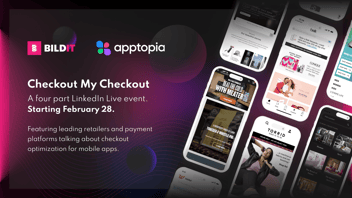Native checkout: the mobile app feature that instantly drives conversions
Picture this: you've spent your time shopping through the app of your favorite eCommerce brand when you're ready to seal the deal and make your purchase. It's time to check out. Now you need to input your address and other information. You make a typo and have to start over again. You're fumbling for your credit card. You struggle to remember that password you made three years ago. You start to wonder whether the purchase is really worth the fuss. Don't let the mess get in the way of your customer's purchase. There's an easier solution. It's called native checkout––and there's a reason it instantly increases conversions by .4%.
What is native checkout?
In the world of software, native refers to any piece of software that is designed specifically for the platform on which it lives. With native checkout, that means that instead of contorting a review checkout experience to fit mobile, developers create one specifically for in-app usage.
 What does this mean practically? It means that the UI (user interface) will load faster and have fewer overall errors. By cutting out all the stuff between webview and app, native checkout creates a smoother user experience.
What does this mean practically? It means that the UI (user interface) will load faster and have fewer overall errors. By cutting out all the stuff between webview and app, native checkout creates a smoother user experience.
If you’ve ever made a purchase in the app store using touch ID, then you’re familiar with native checkout. With a good native checkout, the customer doesn’t need to enter their credit card number, password, or personal information every time they make a purchase. It’s all already stored in the app.
By connecting native checkout to biometric authentication, purchases can be made with literally one touch.
How does it improve the user experience?
According to a 2017 Oxford University and Mastercard study, 33% of abandoned carts can be attributed to forgotten passwords. Removing any interference with the completion of the checkout process not only provides the obvious benefit of immediately increased revenue but also contributes to a happier overall customer base.
If a store clerk were to stop you at the checkout counter in Macy’s to ask you for your credit card number, zip code, and mother’s maiden name, you might put down your would-be purchase and walk right out of the store. Just like in the physical world, in-app consumers want the actual paying part of shopping to be as painless as possible.
When it comes to ecommerce, we simply cannot undervalue the importance of speed. Amazon reports that for every extra 100 ms of latency they lose 1% in sales. Anything that increases the time it takes for a user to shop could literally cost retailers millions. Native checkout benefits brands by ensuring that the UI is pre-downloaded––no wait time, just shopping.
In 2020, we took a look at some of the best (and worst) mobile app checkout experiences available. Retail icon Macy’s took 1st place with PacSun sliding in at 4th.
PacSun was effective in creating a fast native checkout that even offers useful capabilities like credit card entry through camera. Points were docked because the app did not accept alternative payment options like Apple Pay and Google Pay. App’s checkout should account for diversity in customer preferences for payment choices.
On the lower side of the spectrum, ranking in 55th place was Bath and Body Works. Rather than offering an in-app native checkout experience, the skincare retailer forces the consumer to enter a web browser in order to checkout. Making a purchase via app requires multiple logins and can be restrictively time consuming. These issues could be solved (and ecommerce revenue increased) by creating a native app with native checkout functionality.
You can download our full Mobile App Checkout Index here.
So why isn’t native checkout everywhere?
In an iOS landscape where native apps have a 30% higher conversion rate than web-based apps, why would a company decide against utilizing native checkout? Well, especially for large retailers who have already long ago built out their web content and order fulfillment process, it’s clunky to set up and maintain an app that is based on a totally different system.
The good news is, this offers an opportunity for smaller and emerging retailers to implement an app feature that will unquestionably increase conversions.
Until now, creating a fully native app with native checkout required more time and effort than many companies were willing to initially invest. To fill the growing consumer demand for excellently crafted ecommerce apps, we started BILDIT.
You can learn more about how BILDIT can meet your company’s needs by requesting a demo here.












